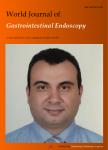Pancreatoscopy: An update
Pancreatoscopy: An update作者机构:Gastroenterology and Digestive Endoscopy Unit Ospedali Riuniti Marche Nord Digestive Endoscopy Unit Division of Gastroenterology Humanitas Research Hospital Humanitas University Gastroenterology Unit University Medical Center "Mother Theresa" Hospital Gastrointestinal Endoscopy Unit Humanitas Mater Domini
出 版 物:《World Journal of Gastrointestinal Endoscopy》 (世界胃肠内镜杂志(英文版)(电子版))
年 卷 期:2019年第11卷第1期
页 面:22-30页
主 题:Pancreatoscopy Per-oral pancreatoscopy Endoscopic retrograde cholangiopancreatography SpyGlass
摘 要:Per-oral pancreatoscopy(POPS) is an endoscopic procedure to visualize the main pancreatic duct. POPS specifically has the advantage of direct visualization of the pancreatic duct, allowing tissue acquisition and directed therapies such as stones lithotripsy. The aim of this review is to analyze and summarize the literature around pancreatoscopy. Pancreatoscopy consists of the classic technique of the mother-baby method in which a mini-endoscope is passed through the accessory channel of the therapeutic duodenoscope. Pancreatoscopy has two primary indications for diagnostic purpose. First, it is used for visualization and histological diagnosis of intraductal papillary mucinous neoplasms. In these cases, POPS is very useful to assess the extent of malignancy and for the study of the intraductal papillary mucinous neoplasm in order to guide the surgery resection margins. Second, it is used to determine pancreatic duct strictures,particularly important in cases of chronic pancreatitis, which is associated with both benign and malignant strictures. Therefore POPS allows differentiation between benign and malignant disease and allows mapping the extent of the tumor prior to surgical resection. Also tissue sampling is possible, but it can be technically difficult because of the limited maneuverability of the biopsy forceps in the pancreatic ducts. Pancreatoscopy can also be used for therapeutic purposes, such as pancreatoscopy-guided lithotripsy in chronic painful pancreatitis with pancreatic duct stones. The available data for the moment suggests that, in selected patients, pancreatoscopy has an important and promising role to play in the diagnosis of indeterminate pancreatic duct strictures and the mapping of main pancreatic duct intraductal papillary mucinous neoplasms. However, further studies are necessary to elucidate and validate the pancreatoscopy role in the therapeutic algorithm of chronic pancreatitis.



